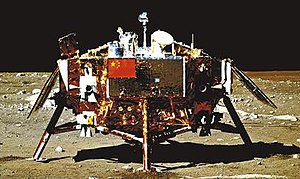
Back تشانج آه 3 Arabic Чанъе-3 Bulgarian Chang'e 3 Catalan Čchang-e 3 Czech Chang’e 3 German Τσανγκέ 3 Greek Chang'e 3 Spanish چانگ ای ۳ Persian Chang’e 3 Finnish Chang'e 3 French
Top: Chang'e 3 lander on the Moon Bottom: Yutu rover on lunar surface | |
| Mission type | Lander and rover |
|---|---|
| Operator | CNSA |
| COSPAR ID | 2013-070A |
| SATCAT no. | 39458 |
| Mission duration | Lander: 1 year (planned) Current: 10 years, 4 months, 14 days Rover: 3 months (planned)[1] Final: 2 years, 229 days |
| Spacecraft properties | |
| Manufacturer | China Academy of Space Technology (CAST) |
| BOL mass | 3,780 kg (8,330 lb)[2] |
| Landing mass | 1,200 kg (2,600 lb) Rover: 140 kg (310 lb)[3] |
| Dimensions | Rover: 1.5 m (4.9 ft) long, 1.0 m high |
| Start of mission | |
| Launch date | 17:30, 1 December 2013 (UTC) UTC[4] |
| Rocket | Long March 3B Y-23 |
| Launch site | Xichang LC-2 |
| Contractor | |
| Lunar lander | |
| Landing date | 13:11, 14 December 2013 (UTC) UTC |
| Landing site | Mare Imbrium 44°07′17″N 19°30′42″W / 44.1214°N 19.5116°W |
Chang'e probes | |
| History of the People's Republic of China |
|---|
 |
| History of |
|
|
Chang'e 3 ( /tʃæŋˈʌ/; Chinese: 嫦娥三号; pinyin: Cháng'é Sānhào; lit. 'Chang'e No. 3') is a robotic lunar exploration mission operated by the China National Space Administration (CNSA), incorporating a robotic lander and China's first lunar rover. It was launched in December 2013 as part of the second phase of the Chinese Lunar Exploration Program.[4][5] The mission's chief commander was Ma Xingrui.[6]
The spacecraft was named after Chang'e, the goddess of the Moon in Chinese mythology, and is a follow-up to the Chang'e 1 and Chang'e 2 lunar orbiters. The rover was named Yutu (Chinese: 玉兔; lit. 'Jade Rabbit') following an online poll, after the mythological rabbit that lives on the Moon as a pet of the Moon goddess.[7]
Chang'e 3 achieved lunar orbit on 6 December 2013[8] and landed on 14 December 2013,[9] becoming the first spacecraft to soft-land on the Moon since the Soviet Union's Luna 24 in 1976[10] and the third country to successfully achieve the feat.[11] On 28 December 2015, Chang'e 3 discovered a new type of basaltic rock, rich in ilmenite, a black mineral.[12]
- ^ Laxman, Srinivas (7 March 2012). "Chang'e-3: China To Launch First Moon Rover In 2013". Asian Scientist. Archived from the original on 2 November 2013. Retrieved 5 April 2012.
- ^ "Chang'e-3 Coming Into Focus". Lunar Enterprise Daily. 23 April 2013. Archived from the original on 13 April 2019. Retrieved 26 December 2013.
- ^ "Most Chang'e-3 science tools activated". Archived from the original on 18 December 2013. Retrieved 19 December 2013.
- ^ a b "China Starts Manufacturing Third Lunar Probe". English.cri.cn. Archived from the original on 21 October 2013. Retrieved 2 December 2013.
- ^ "China Readying 1st Moon Rover for Launch This Year". Space.com. 19 June 2013. Archived from the original on 22 August 2017. Retrieved 23 July 2013.
- ^ He Huifeng (26 March 2015). "China's moon mission chief Ma Xingrui named party chief of high-tech hub Shenzhen". South China Morning Post. Archived from the original on 2 December 2017. Retrieved 4 April 2015.
- ^ Ramzy, Austin (26 November 2013). "China to Send 'Jade Rabbit' Rover to the Moon". The New York Times. Archived from the original on 27 June 2018. Retrieved 2 December 2013.
- ^ "China moon rover enters lunar orbit: Xinhua". www.spacedaily.com. Archived from the original on 7 May 2016. Retrieved 8 December 2013.
- ^ "China lands Jade Rabbit robot rover on Moon". BBC. 14 December 2013. Archived from the original on 12 January 2020. Retrieved 20 June 2018.
- ^ Barbosa, Rui C. (14 December 2013). "China's Chang'e-3 and Jade Rabbit duo land on the Moon". NASAspaceflight.com. Archived from the original on 31 December 2017. Retrieved 14 December 2013.
- ^ "China Becomes Third Country to Ever 'Soft-Land' on the Moon". The Atlantic. 14 December 2013. Archived from the original on 29 May 2019. Retrieved 26 April 2019.
- ^ Bhanoo, Sindya N. (28 December 2015). "New Type of Rock Is Discovered on Moon". The New York Times. Archived from the original on 19 September 2018. Retrieved 29 December 2015.
© MMXXIII Rich X Search. We shall prevail. All rights reserved. Rich X Search

